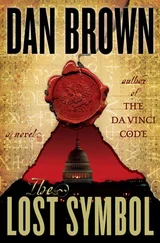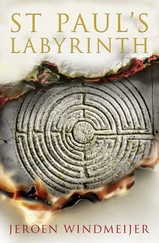Sinskey looked equally alarmed and drew a breath as if preparing to interrogate Brüder further, but she apparently thought better of it, turning instead to Langdon. “Which way?”
Langdon pointed to their left around the southwest corner of the building. “The Fountain of Ablutions is over here,” he said.
Their rendezvous point with the museum contact was an ornately latticed wellhead that had once been used for ritual washing before Muslim prayer.
“Professor Langdon!” a man’s voice shouted as they drew near.
A smiling Turkish man stepped out from under the octagonal cupola that covered the fountain. He was waving his arms excitedly. “Professor, over here!”
Langdon and the others hurried over.
“Hello, my name is Mirsat,” he said, his accented English voice brimming with enthusiasm. He was a slight man with thinning hair, scholarly-looking glasses, and a gray suit. “This is a great honor for me.”
“The honor is ours,” Langdon replied, shaking Mirsat’s hand. “Thank you for your hospitality on such short notice.”
“Yes, yes!”
“I’m Elizabeth Sinskey,” Dr. Sinskey said, shaking Mirsat’s hand and then motioning to Brüder. “And this is Cristoph Brüder. We’re here to assist Professor Langdon. I’m so sorry our plane was delayed. You’re very kind to accommodate us.”
“Please! Think nothing of it!” Mirsat gushed. “For Professor Langdon I would give a private tour at any hour. His little book Christian Symbols in the Muslim World is a favorite in our museum gift shop.”
Really? Langdon thought. Now I know the one place on earth that carries that book.
“Shall we?” Mirsat said, motioning for them to follow.
The group hurried across a small open space, passing the regular tourist entrance and continuing on to what had originally been the building’s main entrance — three deeply recessed archways with massive bronze doors.
Two armed security guards were waiting to greet them. Upon seeing Mirsat, the guards unlocked one of the doors and swung it open.
“Sağ olun,” Mirsat said, uttering one of a handful of Turkish phrases Langdon was familiar with — an especially polite form of “thank you.”
The group stepped through, and the guards closed the heavy doors behind them, the thud resonating through the stone interior.
Langdon and the others were now standing in Hagia Sophia’s narthex — a narrow antechamber that was common in Christian churches and served as an architectural buffer between the divine and the profane.
Spiritual moats , Langdon often called them.
The group crossed toward another set of doors, and Mirsat pulled one open. Beyond it, instead of the sanctuary he had anticipated seeing, Langdon beheld a secondary narthex, slightly larger than the first.
An esonarthex , Langdon realized, having forgotten that Hagia Sophia’s sanctuary enjoyed two levels of protection from the outside world.
As if to prepare the visitor for what lay ahead, the esonarthex was significantly more ornate than the narthex, its walls made of burnished stone that glowed in the light of elegant chandeliers. On the far side of the serene space stood four doors, above which were spectacular mosaics, which Langdon found himself intently admiring.
Mirsat walked to the largest door — a colossal, bronze-plated portal. “The Imperial Doorway,” Mirsat whispered, his voice almost giddy with enthusiasm. “In Byzantine times, this door was reserved for sole use of the emperor. Tourists don’t usually go through it, but this is a special night.”
Mirsat reached for the door, but paused. “Before we enter,” he whispered, “let me ask, is there something in particular you would like to see inside?”
Langdon, Sinskey, and Brüder all glanced at one another.
“Yes,” Langdon said. “There’s so much to see, of course, but if we could, we’d like to begin with the tomb of Enrico Dandolo.”
Mirsat cocked his head as if he had misunderstood. “I’m sorry? You want to see … Dandolo’s tomb?”
“We do.”
Mirsat looked downcast. “But, sir … Dandolo’s tomb is very plain. No symbols at all. Not our finest offering.”
“I realize that,” Langdon said politely. “All the same, we’d be most grateful if you could take us to it.”
Mirsat studied Langdon a long moment, and then his eyes drifted upward to the mosaic directly over the door, which Langdon had just been admiring. The mosaic was a ninth-century image of the Pantocrator Christ — the iconic image of Christ holding the New Testament in his left hand while making a blessing with his right.
Then, as if a light had suddenly dawned for their guide, the corners of Mirsat’s lips curled into a knowing smile, and he began wagging his finger. “Clever man! Very clever!”
Langdon stared. “I’m sorry?”
“Don’t worry, Professor,” Mirsat said in a conspiratorial whisper. “I won’t tell anyone why you’re really here.”
Sinskey and Brüder shot Langdon a puzzled look.
All Langdon could do was shrug as Mirsat heaved open the door and ushered them inside.
The Eighth Wonder of the World, some had called this space, and standing in it now, Langdon was not about to argue with that assessment.
As the group stepped across the threshold into the colossal sanctuary, Langdon was reminded that Hagia Sophia required only an instant to impress upon its visitors the sheer magnitude of its proportions.
So vast was this room that it seemed to dwarf even the great cathedrals of Europe. The staggering force of its enormity was, Langdon knew, partly an illusion, a dramatic side effect of its Byzantine floor plan, with a centralized naos that concentrated all of its interior space in a single square room rather than extending it along the four arms of a cruciform, as was the style adopted in later cathedrals.
This building is seven hundred years older than Notre-Dame , Langdon thought.
After taking a moment to absorb the breadth of the room’s dimensions, Langdon let his eyes climb skyward, more than a hundred and fifty feet overhead, to the sprawling, golden dome that crowned the room. From its central point, forty ribs radiated outward like rays of the sun, extending to a circular arcade of forty arched windows. During daylight hours, the light that streamed through these windows reflected — and re-reflected — off glass shards embedded in the golden tile work, creating the “mystical light” for which Hagia Sophia was most famous.
Langdon had seen the gilded ambience of this room captured accurately in painting only once. John Singer Sargent . Not surprisingly, in creating his famous painting of Hagia Sophia, the American artist had limited his palette only to multiple shades of a single color.
Gold.
The glistening golden cupola was often called “the dome of heaven itself” and was supported by four tremendous arches, which in turn were sustained by a series of semidomes and tympana. These supports were then carried by yet another descending tier of smaller semidomes and arcades, creating the effect of a cascade of architectural forms working their way from heaven toward earth.
Moving from heaven to earth, albeit by a more direct route, long cables descended straight down from the dome and supported a sea of gleaming chandeliers, which seemed to hang so low to the floor that tall visitors risked colliding with them. In reality, this was another illusion created by the sheer magnitude of the space, for the fixtures hung more than twelve feet off the floor.
As with all great shrines, Hagia Sophia’s prodigious size served two purposes. First, it was proof to God of the great lengths to which Man would go to pay tribute to Him. And second, it served as a kind of shock treatment for worshippers — a physical space so imposing that those who entered felt dwarfed, their egos erased, their physical being and cosmic importance shrinking to the size of a mere speck in the face of God … an atom in the hands of the Creator.
Читать дальше
Конец ознакомительного отрывка
Купить книгу










